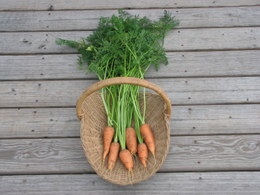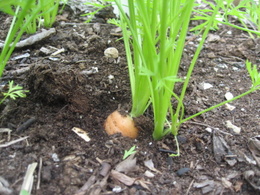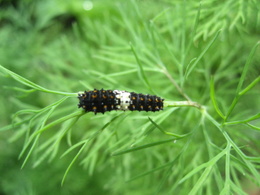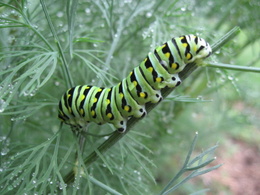Carrot Growing Guide
Carrots (Daucus carota var. sativus) are cool weather vegetables and are frost tolerant. They are biennials, but are normally grown as an annual and harvested at the end of the growing season. If left in the ground over the winter and allowed to flower the seeds can be saved. The root does become woody the second year.
Most are orange, but purple, dark red, yellow and white varieties can be found.
Their history goes back over 5,000-years ago in what is now Afghanistan.
Soil Preparation
They should be planted in deep soil that is free of stones. If the root tip encounters a stone it may become forked or misshapen. The soil should be a nice loose well-drained garden soil with some compost added and blended in before planting. They do best in a slightly acid soil with a pH range of 6.0 to 6.8 and should have 6 to 8-hours of full sun, but can tolerate some light shade during the hot summer weather.
The long 8 to 12-inch varieties should be grown in a loose sandy soil.
Planting Carrots
Carrots do not transplant well and should be direct sown. They will tolerate a light frost and can be direct sown 2 to 3-weeks before your last expected frost. Sow the seeds 1/2-inch deep, 1/2-inch apart in rows about 6 to 12-inches apart, covering with fine cover of soil.
They are slow to germinate taking 1 to 3-weeks to emerge. They should be lightly watered daily to keep the soil damp, but not allowing the soil to get too dry. Placing 1 or 2-layers of window screen a few inches above the soil will help keep the soil damp until they emerge by providing a light shade. Many gardeners will sow some radish seeds along with the carrots in the same row. The radishes will germinate very quickly and mark the row.
Thin to about 2 to 3-inches apart. If they are too crowded the roots may not develop properly. When thinning or weeding be careful not to disturb the root. It is often helpful when thinning to clip off the top with scissors to avoid disturbing the roots.
Watering and Care
After the seeds germinate and are 3 to 4-inches tall start adding a layer of mulch to help retain moisture and keep out competing weeds. They should get an inch of water each week and during dry spells give some water to keep the soil moist. If the soil is allowed to dry out too much and then is watered, the carrot roots may develop cracks.
Harvesting Carrots
Depending on the variety, they may take 60 to 90-days to reach maturity. If they seem to be crowding each other, carefully and gently pull out some for your evening meal. It is not necessary to harvest them all at once.
To prevent damage to the root place a hand trowel several inches away from the root and loosen the soil so that it comes out easily when pulling on the top.
If you let them stay in the ground past the first frost they will get sweeter. At this point you need to get your carrots out of the ground before the soil freezes solid or you need to cover them. If you cover them with a piece of carpet and place some mulch on top of it, you can go out in the winter and still easily dig up some fresh carrots.
If you want to store your carrots in the refrigerator all you need to do is twist off the tops, wash them and put in a plastic bag. Put them in the vegetable drawer where they will keep for 2 to 3-months.
Popular Varieties
Some popular varieties are: Atomic Red, Bambino, Cosmic Purple, Danvers Half Long, Little Finger, Lunar White, Nantes Half Long and Solar Yellow.
Sources: Seeds Now, Burpee, Eden Brothers
Pests
Carrot rust flies lay their eggs in the soil near the carrots and after hatching the larvae tunnel into it damaging it. The carrot root weevil larvae also tunnel into the root. Floating row covers, mulching, rotating crops and planting a resistant variety such as "Flyaway” may help.
The carrot fly is attracted to the carrot by smell, so interrupting the carrot scent can be done by intermixing crops with a strong scent such as onions, chives, garlic, rosemary, sage and marigolds alongside the carrots can help.
The pupa of the carrot rust fly overwinters in the soil, so in the fall remove all weeds and crop debris to disrupt the cycle as much as possible.
Tips and Warnings
Deer, gophers, ground hogs and rabbits will eat the carrot foliage so you may want to use a fence or some deer netting to protect them.
Carrots are one of the host plants of the Black Swallowtail butterfly. Other host plants include dill, parsley, fennel, and Queen Anne’s lace.If there are several caterpillars in one spot you can move them to spread them out over your carrot crop. It is fun to watch them as they grow.
The newly hatched small caterpillar larvae are black with a white band around the middle looking very much like a bird dropping.
They are very small and you may not notice it until it gets to be 1/8 to 1/4-inch long. As it grows it will shed its skin and turn into an attractive stripped caterpillar.
The colorful later stage caterpillars do very little damage, so leave them alone and enjoy them.
Each molting stage is called an instar and it will go through 5-instars getting larger each time. Then it will leave the dill and attach itself to a twig where it will enter the chrysalis stage looking very much like a part of the twig. In 2 to 3-weeks a beautiful Black Swallowtail butterfly will emerge. There are some amazing YouTube videos of the process.
If the upper portion of the carrot neck is exposed to sunlight it will turn green. To prevent this from happening just place enough soil over the carrot neck to cover it.
Garden Spikes newsletters give you timely information once or twice a month. Subscribe Free to the Garden Times newsletter below.
Your email address will only be used to send you a newsletter and will never be sold. You can unsubscribe at any time.




